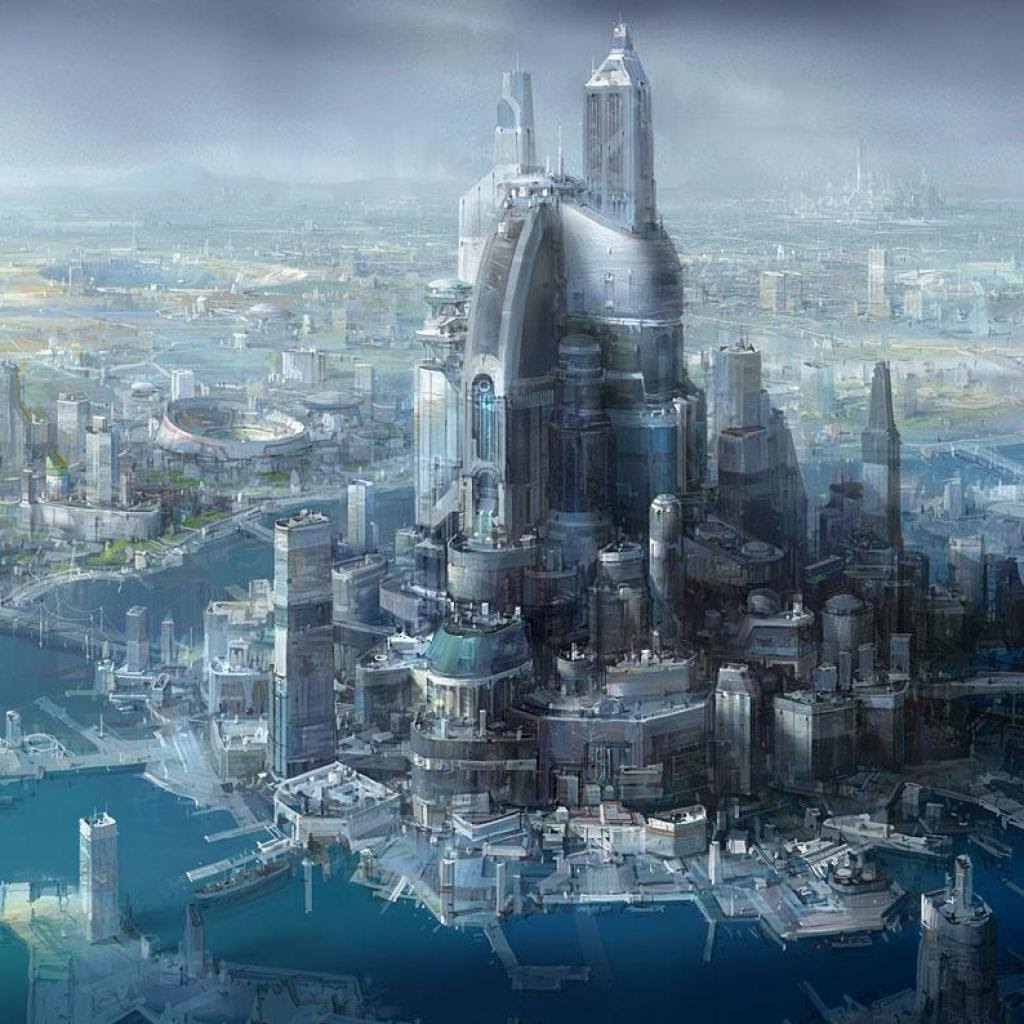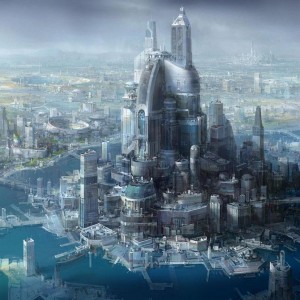
Happy Thursday*, Happy GURPS Day, all! This week, I’m talking a bit more about the gloriously chaotic pan-dimensional city of mayhem, Locus, specifically some more details on the city and its zones. (*In certain dimensions, I may have fallen asleep yesterday before posting, and it’s actually Friday.)
The interior of the sphere in which the city exists is, well below ground level (and unknown by most inhabitants), divided into 12 pentagons and 240 hexagons, each covering an area of roughly a couple square miles. These are the zones, the areas where other dimensions can phase in or out with the rest of the city. Several different kinds exist.
Permanent
While it seems like nothing in Locus is truly permanent, these zones have remained stable and in phase for many years, usually for at least a decade or two, sometimes for centuries.
The 12 pentagon zones are stable by design. The Ventari used these as staging and monitoring areas, and they contain no mechanism for phasing dimensions in or out. They are the only truly permanent areas (again, something most Locusians are unaware of), and are thus highly-prized as places to house all kinds of city infrastructure. Only the strongest factions in the city lay claims to these zones, and they hold onto them until an even more powerful group forces them out.
There are a handful of other zones called permanent by the inhabitants because they have remained in phase for so many years, but they are actually standard hexagon zones that A) have suffered damage to their phasing technology and no longer function, or B) are working fine, but just haven’t been “due” for a new phasing in so long that everyone assumes they’re permanent. They could phase out from Locus at any time, much to the surprise of any beings living there and trapped away from Locus when they do.
 Regular
Regular
These zones seem to comprise the largest overall percentage within Locus. They phase in a new dimension on a precise and regular timetable, whether every few minutes or every few years, and local inhabitants will try to keep up with the schedules of the zones closest to their frequent haunts to avoid surprises.
Locusians are well known for using outbound dimensions as dumping grounds for all sorts of things — in the hours before a dimension phases out (assuming that can be detected), it is often piled high with all manner of waste and debris, dangerous items, prisoners… whatever someone in the city wants to wash their hands of.
Irregular
Irregular zones are dangerous because they phase in new dimensions completely at random, with no discernible pattern. A dimension might phase in for 20 minutes, then be replaced by another for 6 months, which is in turn replaced for 3 days, and on and on. Beings of the city try to avoid living or working in these areas, for obvious reason, but sometimes the potential rewards outweigh the risk.
Reality Strike
A reality strike is not a zone per se, but it can cause dimensional shifts within the city. As if Locus weren’t chaotic enough, millenia without proper maintenance has left the Ventari’s original machinery a bit… twitchy. Occasionally, phasic energy will slowly build up in an area over time, until it reaches a critical mass and discharges in the form of a spectacular burst of energy, like a lightning strike. Anyone or anything touched by one of these strikes is instantly displaced to, literally, any place in the multiverse. This is the Locus equivalent of a natural disaster like a tornado or earthquake — just a random, “wrong place, wrong time” kind of event.
Any being stuck in Locus long enough will become familiar with the effects of these various zone types, though only a handful have even the most rudimentary understanding of the underpinning mechanics. The City simply is as it is, the same way many modern people don’t really understand how a car or a computer works… it just does.
Adding further to the patchwork nature of things, dimensions are not always confined to a single zone. Multiple zones may sync together, so a single dimension could extend over 6, 10, 20 square miles, etc. When that dimension’s time is up and it phases out, the underlying zones might remain synced, or might break back down into single zones or combinations of smaller couplings.
Also of note is that concepts of space and even time mean nothing to the unfathomable phasic technology that fuels Locus. Thus, two different spatial areas of a dimension could be in phase with the city simultaneously. One zone could be host to a few city blocks from Earth in the Milky Way galaxy, while another zone is host to a few square miles of jungle from Tzikleforp in the Tadpole Galaxy. While separated by some 420,000,000 light years outside the city, inside the city they could be less than a day’s walk apart.
Similarly, different points in time can be in phase with the city simultaneously. In the example above, Earth and the Tzikleforpian jungle could both be in phase as they are in the Earth year 1995, or they could be separated by thousands or millions of years of local time. A group of medieval knights could wander into Locus from their zone in the Earth year 1420, walk a few miles, and find themselves in Japan in the Earth year 2377. (This may be one step too far on the gonzo meter for some GMs, but it does make a certain sense. The option is there.)
Finally, each zone is a bit like its own closed ecosystem within its dimensional bubble. A being entering a zone that is in phase with Earth’s Manhattan in mid-December 2015 at midnight will find a nitrogen/oxygen atmosphere, 1 G gravity, and a temperature of 48° F. The dimension of the neighboring zone could be a vast desert at high noon, with a methane atmosphere, 2.5 G gravity, and a temperature of 210° F. All “local” conditions continue to exist. Being in phase with Locus changes nothing about a dimension other than allowing travel to other dimensions also in phase.
So far, I’ve written mainly about the general mechanics and logistics of Locus, the hypotheticals of how the City could be. I’ll likely take a few weeks off from posting more about it here while I work on an outline and table of contents for the eventual PDF, and then start throwing out some ideas on infrastructure, powerful factions, adventure seeds, the specifics of how it actually is.
Thank you, everyone, for all the great feedback you’ve sent my way! It’s been extremely helpful in making decisions about the setting, and I hope you’ll enjoy the final product whenever it’s done. See ya next week.
If you enjoyed this post and others like it, might you consider the Game Geekery Patreon?
Leave a Reply